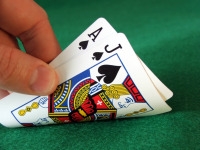One of the most confusing concepts in blackjack strategyis the idea that you should never split 10's.
The logic behind not splitting tens is that you already have a great hand and shouldn't break it up to go for two wins.
Even still, many players like to try their luck splitting 10's because it gives them a shot at two winning hands – especially when the dealer has a weak upcard in the range of 4-6.
Besides the dealer having a week card, a player should at least win one of the hands if things go south. But simple logic doesn't always beat the numbers when everything is said and done.
Stand vs. Split with Tens
You're a good blackjack bet to beat the dealer when holding two 10's no matter what the dealer's upcard is.
But if the dealer holds anything from 4 to 6, your chance of beating the dealer by standing with tens skyrockets to around 85%.
However, if you split the two 10's, your chances of beating the dealer fall to around 65% (per hand).
Obviously the percentages show that splitting will lower your winning percentage, but the real question is if it will lower your profits too.
Because you still have to consider that, even with a 65% win rate, you have a chance at doubling your bet.
So let's take a quick look at whether or not doubling with 10's will reduce your profits in addition to the win rate.
Measuring Profits
In our example for splitting vs. standing, we'll use a 100 hand sample to determine which is more profitable.
Taking one win/one loss hands out of the equation, you win $2 by splitting with tens 65% ($130 total) of the time, and you lose $2 by splitting with tens 35% ($70) of the time.
After doing some quick math ($130 – $70), you'll find that you profit by $60 per 100 hands (60 cents per hand) by splitting with a pair of tens.
However, standing with 10's is much more profitable in the end when you consider that you're making 70 cents ($85 – $15) per hand.
So keep this in mind next time you think about telling the dealer to split your tens.



